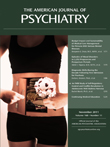Epistemological Tension in the Future of Personality Disorder Diagnosis
To the Editor: In August 2011, the DSM-5 Personality and Personality Disorders Work Group posted an update presenting a hybrid dimensional-categorical model that attempts to embrace cutting-edge personality science while increasing clinical applicability and utility. These two aims pull in somewhat different directions, with personality science roughly represented by the dimensional component of the proposed model and clinical application and utility roughly represented by the categorical side. Pending field testing, this hybrid model may represent the future of personality disorder diagnosis. If so, it will not only transform DSM, but it will also reveal a deep epistemological tension in the diagnosis of personality pathology.
Bruner (1) suggested that there are two fundamentally distinct modes of human thought. He labels one the “paradigmatic mode,” which is essentially the mode of science. Paradigmatic approaches are concerned with the construction of rational arguments, striving toward an idealized system of description and categorization. Bruner labels the other approach the “narrative mode,” which is concerned with the meaning humans ascribe to events. Narrative approaches capture the dynamic ways in which we attempt to understand our experiences, structuring them into storied arcs that enable us to hold onto the often elusive and fluid past. Bruner is careful to explain that neither mode of thought is to be privileged; the two are complimentary and one cannot be reduced to the other.
Proponents of a dimensional approach to the future of personality disorder diagnosis cite the impressive accumulation of sophisticated research modeling the underlying structure of personality and its pathological variants. It is hard to deny the resounding clarity with which the scientific data point toward a dimensional system. Yet it is just as hard to deny the accumulated experience of practitioners who have equally clear conceptions of the nature of disordered personality. In the daily practice of clinicians, patients are not living clusters of dimensional traits; they are discrete beings who suffer in categorically different ways. We simply cannot declare either position “correct,” for they must be judged using fundamentally different rules. Proponents of dimensional diagnoses are “correct” from paradigmatic perspectives—the science points unequivocally toward trait-like spectra of personality pathology. Proponents of categorical diagnoses are “correct” from narrative perspectives—comments on the proposed DSM-5 revisions from just about everyone except personality researchers advocate the importance of retaining demarcated types of personality disorders. The two sides appeal to distinct epistemologies in making their claims.
My goal is not to weigh in on which approach ought ultimately to be adopted in DSM-5. Indeed, as the current proposal makes clear, a hybrid model may ultimately succeed, satisfying everyone (and likely no one completely). Instead, I am suggesting that the debate ahead is not best understood as ideological, but epistemological. The question is not whose ideas are better, but how to grapple with competing standards of proof. The way forward is for advocates on each side to retain their core beliefs while effectively and cooperatively translating them across the epistemological divide.
1. : Actual Minds, Possible Worlds. Cambridge, Mass, Harvard University, 1986Google Scholar



